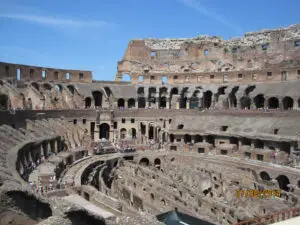Yesterday evening I watched the movie Gladiator. And something didn`t seem right. Many roman mosaics about gladiators show referees and yet the Movie did not show any referees or rules that the Gladiators had to follow.
That got me thinking: Did Gladiator fights have rules or were they the anarchic slaughters that are portrayed in movies.
Let’s find out together…
Gladiator fights did have referees and rules but the exact rules did not survive the fall of the Roman empire and got lost over time.
Did Gladiator fights have rules?
We know from several sources that gladiator fights had rules. The problem is that the exact rules were not handed down to our time or more precisely got lost after the end of the gladiator games.
More on why the gladiator games ended here in my article.
But due to the documents, roman writers left behind we do know that there must have been rules. For example:
Documents of Suetonius
The roman writer Suetonius (who lived from 69 to after 122 AD) is famous for writing biographies about 12 roman emperors, from Julius Caesar to Domitian.
These biographies are called De vita caesarium (literal translation: About the Life of the Caesars) but are more commonly known as The twelve caesars.
Digression: why were all roman emperors called caesar?
You might wonder why the book is called „About the life of the 12 caesars“ when only Julius Caesar is named Caesar.
The answer is that all roman emperors traced their claim to legitimacy back to Julius Caesar. So in a way, caesar became a synonym for Emperor.
The German word for Emperor, „Kaiser“ actually sounds extremely similar to and originates from the Latin „Caesar“.
By the way: Do you wonder why Julius Caesar never proclaimed himself king? You can find the answer here in my article!
End of digression
But let’s go back to Suetonius and why his documents prove the existence of rules in gladiator fights.
In section 30, 2 Sueton descibes a duell between 5 retiarii and 5 secutores. Click here for my article with more information about the different and clearly defined types of gladiators.
To sum the article up, roman gladiators were not just randomly armored. There were types of Gladiators and every Type of gladiator had its specific armor, weapon, and enemy.
The Secutor, a well-protected swordsman who was armed with the gladius, the roman shortsword would fight against the retiarius.
Here you can find my article with more information on how gladiators fought.
The Retiarius was a type of Gladiator who fought with almost no armor and used the net, the trident, and a gladius as his weapons.
Suetonius describes a fight between 5 retiarii and 5 secutores. The retiarii threw down their weapons before fighting as an act of surrender. You can find more information about how the gladiators’ fights worked here in my article.
After the secutores received the order to kill the surrendering net fighters one of the net fighters grabbed his trident and killed all of the secutores.
How does Suetonius document proof the rules of Gladiator fights?
Now that might seem like a reasonable thing to do. If your opponent is tasked with executing you you might want to kill him first.
But that was not how duels between gladiators had to end according to the rules. There were 5 ways a Gladiator fight could end. I will link you my article on the 5 different options here.
But now I only want to shortly explain one way, the surrender of one of the opponents (or in the case that Suetonius describes one of the groups), a fight could end.
After a gladiator had surrendered he and his victorious opponent had to wait for further instructions.
It was up to the organizer of the gladiatorial games to decide the fate of the surrendering gladiator.
Now since the games were held for political purposes, more Information in my article here, the organizer would usually consider the mood of the watching crowd. Do you want to learn more about why Gladiators fought at all? Check out my article here!
For that reason, the mortality rate of veteran gladiators who had a fan base was much lower than that of new gladiators. More information on the shocking mortality rate of gladiators here in my article.
If the organizer decided that the gladiator did not fight well enough to grant him his life it was expected from the victorious gladiator to kill his opponent. And it was expected of the defeated Gladiator to receive the deadly blow without any form of Emotion or pleading for mercy.
The ability of a gladiator to die without any sort of shown emotion was one of the things Romans admired!
By the way, the potential killing of the surrendering gladiator was also the reason why the gladiators kept their helmets on after the duel ended. Many opponents, especially the ones that were trained together, had a personal bond and were often friends, or since most of them did not voluntarily become gladiators, at least fellow sufferers.
Here you can find my article with more information about the social background of gladiators and what happened to the social status of the occasional free man who chose to become a gladiator.
The fact that the gladiators kept their face-covering helmets on even after the fight was over can be seen as an attempt to make it easier for them to potentially kill their defeated friend.
In the described incident, the surrendering net fighter who killed his executioner was so against the roman ideas of the games that, according to Suetonius, the Emporer Caligula, who was a big fan of the gladiator fights, lamented about the insidious carnage. By the way, Caligula himself fought as a Secutor! And he was actually quite good et it earning the rank of primus palus. More on the hierarchy among Gladiators in my article here.
Here you find my article with more information on the Secutor.
Conclusion
The anger Caligula shows over the behavior of the net fighter clearly shows that that kind of behavior was not allowed and was against the rules of the gladiatorial fights.
Another evidence for the existence of rules in gladiatorial duels are roman mosaics that show referees.
Did Gladiator fights have referees?
Gladiator fights did have referees. On original roman mosaics, these tunica-wearing referees can clearly be distinguished from the gladiators who fought with a bare chest.
Many Roman mosaics of gladiator fights show one or two men who are dressed in tunics and equipped with staff.
These men are noticeable since most types of gladiators fought with a bare chest.
In the mosaics, these men are also not uninvolved. Since most mosaics show the end of a fight the referees are usually shown while separating the two gladiators with their staff.
The presence of referees is another clear indicator that roman gladiator fights actually had rules.
Who were the referees of Roman gladiator fights?
It is not entirely clear what social status the referees had.
But it seems likely that the referees were former gladiators who stayed connected with the arena even after they were released. Check out my article here to learn more about the limited career opportunities former gladiators had.
Some sources indicate that the referees were actually well respected but again, the amount of sources for that topic is quite slim.
However, it seems reasonable that men who spent years in the arena and who had a skill set that was not really usable outside the arena would stay connected to the gladiatorial games.
You want to learn more about Gladiators? We have many more articles about the fascinating world of the roman Gladiators. Enjoy!
Take care of yourself because you deserve it. You really do.
Until next time
Yours truly
Luke Reitzer
Sources
K. Nossov; Gladiator: The complete Guide to Ancient Rome`s Bloody fighters (2011).
F. Meijer; Gladiatoren. Das Spiel um Leben und Tod (Amsterdam 2003).
M. Junkelmann, Das Spiel mit dem Tod. So kämpften Roms Gladiatoren (Mainz am Rhein 2000).


